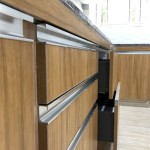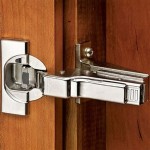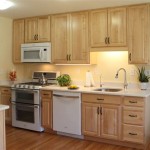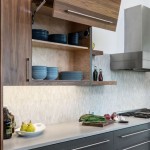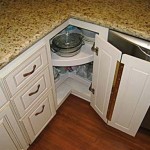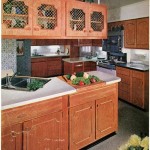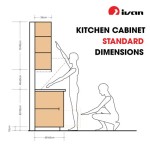Measuring Kitchen Cabinet Hinges: A Comprehensive Guide
Accurate measurement of kitchen cabinet hinges is crucial for successful replacement or installation. Hinges come in a variety of types and sizes, and selecting the correct replacement requires a thorough understanding of the dimensions and specifications of the existing hinges. This article provides a detailed guide to measuring kitchen cabinet hinges, covering various hinge types and the key measurements to consider. By following these instructions, individuals can confidently identify and order the appropriate hinges, ensuring a smooth and functional cabinet installation.
Properly measured hinges prevent issues such as misaligned doors, strained hinge mechanisms, and ultimately, the premature failure of the hinges and even the cabinet structure. Furthermore, understanding the different hinge types and their specific measurement requirements will save time and reduce the frustration associated with incorrect part orders. Precise measurements guarantee the new hinges match the existing bore holes and mounting positions minimizing the need for cabinet modifications.
Identifying the Hinge Type
Before commencing measurements, identifying the type of hinge is paramount. Kitchen cabinets utilize a variety of hinge types, each with distinct characteristics and measurement requirements. The most common types include:
*Overlay Hinges:
These hinges mount on the inside of the cabinet frame and allow the cabinet door to partially or fully overlay the frame. Overlay hinges are typically used when the cabinet doors cover a portion of the cabinet frame's face. Determining the overlay amount (partial or full) is essential for selecting the correct replacement hinge. *Inset Hinges:
Inset hinges are designed for cabinet doors that sit flush with the cabinet frame. These hinges are fully concealed when the cabinet door is closed, providing a clean and minimalist aesthetic. *Full-Inset Hinges
: A door mounted with this type of hinge fits fully within the cabinet frame. *Partial-Inset Hinges
: A door mounted with this type of hinge fits partially into the cabinet frame. *Face Frame Hinges:
These hinges are specifically designed for cabinets with a face frame – a wooden frame attached to the front of the cabinet box. Face frame hinges are typically attached to both the face frame and the cabinet door. *Frameless (Euro) Hinges:
Also known as concealed hinges, these hinges are designed for frameless cabinets, where the cabinet box is constructed without a face frame. Euro hinges are mounted inside the cabinet box and are almost entirely invisible when the door is closed. They are known for their adjustability. *Butt Hinges:
Butt hinges are traditional hinges typically mortised into both the cabinet door and the cabinet frame. They are visible when the door is closed. *Pivot Hinges:
These hinges allow the cabinet door to swing open from a pivot point located at the top and bottom of the door. Pivot hinges are often used for specialty cabinets or doors with unique design features.Once the hinge type has been identified, the measurement process can begin. The process will vary slightly depending on the type of hinge but requires meticulous attention to detail.
Key Measurements for Hinge Replacement
The specific measurements required will depend on the hinge type, but some core measurements are generally applicable. These measurements are critical for determining the correct replacement hinge and ensuring a proper fit.
*Overlay Measurement:
For overlay hinges, determining the overlay distance is crucial. The overlay refers to the amount the cabinet door overlaps the cabinet frame. To measure the overlay, close the cabinet door and measure the distance from the edge of the door to the inside edge of the cabinet frame. This measurement will determine the necessary overlay hinge size. Overlay amounts are often expressed in inches or millimeters (e.g., 1/2" overlay, 1" overlay, etc.). *Bore Diameter and Hole Pattern:
For Euro-style (frameless) hinges, the bore diameter and hole pattern are essential measurements. The bore diameter refers to the size of the hole drilled into the cabinet door to accommodate the hinge cup. Standard bore diameters are typically 35mm or 40mm. The hole pattern describes the arrangement of the screw holes around the hinge cup bore. The center-to-center distance between the screw holes must be measured accurately. These measurements are usually expressed in millimeters. *Hinge Length and Width:
For butt hinges and other visible hinges, the overall length and width of the hinge leaf are essential measurements. Measure the length from the top to the bottom of the hinge leaf and the width when the hinge is fully open. These measurements ensure the replacement hinge will fit within the existing mortise cutouts. *Hinge Height:
The height of the hinge is the dimension from the top to the bottom of the hinge when it is closed. This dimension is particularly important for butt hinges and other visible hinges where the existing mortise cutouts must align with the new hinge. *Screw Hole Distance:
The distance between the screw holes on the hinge is another critical measurement. This measurement must be taken accurately to ensure the new hinge aligns with the existing screw holes in the cabinet door and frame. *Hinge Cup Depth:
For concealed hinges, the depth of the hinge cup is an important measurement. This measurement refers to the depth of the circular recess in the cabinet door where the hinge cup sits. Using a caliper to measure the existing hinge cup depth can ensure the replacement hinge is compatible. *Opening Angle:
Measuring the opening angle is important. This refers to how far the door will open when the hinge is fully extended. Typical opening angles for cabinet hinges include 95 degrees, 110 degrees, 170 degrees, and others. Choosing the correct opening angle ensures the cabinet door functions as intended. *Thickness:
The thickness of the hinge material itself can also be a factor, particularly when dealing with older cabinets or unique hinge designs. Measure the thickness of the hinge leaf using calipers to ensure the replacement hinge is of similar gauge.It is recommended to use precise measuring tools, such as a caliper and steel ruler, for accurate readings. All measurements should be recorded meticulously to avoid errors when ordering replacement hinges. Photographing the existing hinge and noting any identifying marks or manufacturer stamps can also be helpful.
Practical Steps for Measuring Different Hinge Types
The application of the general principles mentioned above varies subtly based on the specific hinge type. The following outlines practical steps for measuring the most common types of kitchen cabinet hinges:
*Euro (Frameless) Hinges:
Remove one of the hinges carefully. Measure the bore diameter (usually 35mm or 40mm). Measure the distance between the screw holes, making sure to note the pattern (e.g., straight line, triangular). Determine the overlay amount by examining how the door sits in relation to the cabinet box. Note if markings exist from the manufacturer; this may directly lead to a replacement hinge. *Overlay Hinges:
Close the cabinet door and measure the overlay distance from the edge of the door to the inside edge of the cabinet frame. Remove the hinge from the door and frame and measure the overall height and width of the hinge. Note the style of the hinge (e.g., self-closing, soft-close). *Inset Hinges:
Note whether they are full or partial inset hinges. With the door closed measure the gap between edge of the door and the face frame (should be zero with full inset). Detach the hinges. Note size of screw holes and their distance from face to face. Measure hinge cup depth. *Butt Hinges:
Remove the hinge from the door and frame. Measure the overall length, width, and thickness of the hinge leaf. Measure the distance between the screw holes. Note the shape of the hinge leaves (square or rounded corners). *Pivot Hinges:
Measure the diameter of the pivot pin. Measure the length of the mounting plate. Measure the thickness of the mounting plate. Note if the hinge is adjustable.When replacing multiple hinges on a single cabinet door, it is advisable to replace all hinges simultaneously to ensure uniform performance and alignment. Mixing old and new hinges can create uneven stresses on the cabinet door and frame, potentially leading to premature wear or failure.
Moreover, when dealing with antique or custom-built cabinets, identifying and sourcing replacement hinges can be more challenging. In such cases, consulting with a professional cabinet maker or hardware specialist may be necessary. These professionals can often provide expert advice on hinge identification, measurement, and sourcing compatible replacement hinges or alternate solutions.
By meticulously measuring kitchen cabinet hinges and understanding the nuances of different hinge types, one can avoid errors and ensure a successful installation or repair. The time invested in accurate measurement will ultimately save time, money, and frustration in the long run, resulting in well-functioning and aesthetically pleasing kitchen cabinets.
Measuring Hinge Holes

How To Measure Hinges For Kitchen Doors Kdh

Measuring Hinge Holes

How To Measure Hinges For Kitchen Doors Kdh

How Do I Measure My Kitchen Doors Beautiful

Measuring Hinge Holes

How To Measure Cabinet Hinges Venace

3 Simple Ways To Measure Cabinet Hinges Wikihow

3 Simple Ways To Measure Cabinet Hinges Wikihow

How To Measure Your Doors And Drawer Fronts A Guide

